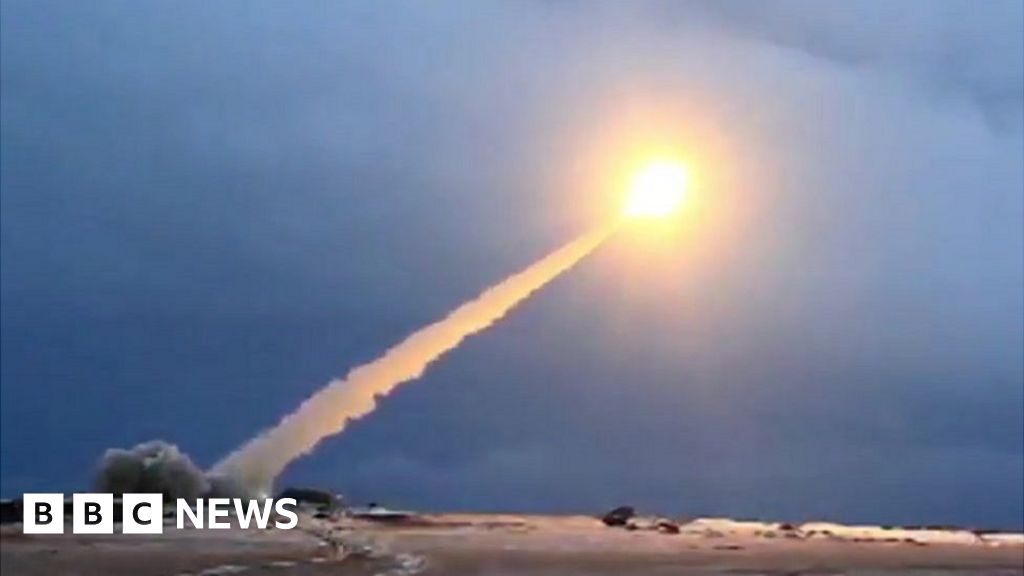Forest Green
ACCESS: Above Top Secret
- Joined
- 11 June 2019
- Messages
- 9,546
- Reaction score
- 17,531
That's a good question, it was on YouTube but I wouldn't even know how to start looking for it.Which sources?
Actually, I found it.
That's a good question, it was on YouTube but I wouldn't even know how to start looking for it.Which sources?
Huh? Like?..Like their hollow missile shells on parade for the last umpteen years?

Called it.
Russian authorities clear villages near nuclear test site as it emerges radiation levels rose after recent blast
As concerns over another possible nuclear incident in the Russian Arctic grow, authorities in Arkhangelsk region have asked residents of a town near a missile test range to evacuate their homes tomorrow while the military conducts “planned activities,” it has been reported.www.telegraph.co.uk
Have they Chernobyl'd it again?
That's a good question, it was on YouTube but I wouldn't even know how to start looking for it.Which sources?
Actually, I found it.
I know but hey, we're working on assumptions all the way here. In many ways it makes no sense to have a nuclear turbofan instead of a ramjet. It's slower, it weighs more, it's larger and there are no relevant range benefits.Oh, such a reliable source it is
So this is supersonic, Mach 2.9 vehicle. OKI know but hey, we're working on assumptions all the way here. In many ways it makes no sense to have a nuclear turbofan instead of a ramjet. It's slower, it weighs more, it's larger and there are no relevant range benefits.
I heard Yoyodyne was the contractorCredit to Flateric
12 ) United States Patent
Podrog
( 10 ) Patent No . : US 9 , 797 , 309 B2
( 45 ) Date of Patent : * Oct . 24 , 2017
( 54 ) HAFNIUM TURBINE ENGINE AND METHOD OF OPERATION
If it works, it’s ideal for miniaturisation in a small sub sonic craft. The Hafnium source would be the size of a coin;- 15g has the same stored energy as 2 tons of kerosene.
Hafnium this or that strikes me as Cold-Fusionesque. Too good to be true.
'The Future begins Tomorrow'.I heard Yoyodyne was the contractor
Depends what sweep angle it flies with.So this is supersonic, Mach 2.9 vehicle. OK
One can fall down a rabbit hole of speculation. Consider: a lot of people got excited about hafnium isomers, a fair chunk of cash was spent on the idea, and the it was found to *apparently* be fundamentally flawed. But there's enough uncertainty that *maybe* it can work. But how about if the Russians spent *more* money studying and determined that it absolutely WILL NOT WORK. It's a lost cause. It's impossible. So why waste another minute on it?
For dirty tricks, that's why. Make it *look* like you've got a functional, or at least semi-functional, small and practical nuclear turbojet. Make it look like a hafnium isomer system, or a miniaturized plutonium or californium or whatever you want system. "Accidentally" trash one; this releases a burst of gamma/neutron/X-ray radiation that can be measured, along with a cloud of isotopes, all of which are tailored to make your "reactor" look like a hafnium/californium/whatever reactor. And after you've "accidentally" crashed one, fly another one around that is seemingly successful (even though it has only a conventional turbojet, an ultra-lightweight structure and nothing but a whole lot of fuel). The Americans and Japanese and Brits and whoever else will analyze the evidence you've scattered about and will decide "holy crap, the Russians have figured out how to make an unobtainum reactor," and will then blow a bajillion dollars on their own futile pursuit of the same thing. Not only with the US throw away buckets of cash, but the best minds in nuclear power, minds which could be doing something useful like designing NERVA engines or power reactors for subs or next-gen nukes, will be wasted on a useless pursuit of an impossible goal.
Further down the rabbit hole: The Russians find that the engine isn't 100% impossible, but they just can't seal the deal on it. Try as they might they just can't make it work. But if they convince the US that the Russians have it, the US will work on it until they've got it figured out. And since the Russians have spies everywhere, as soon as the US figures it out, the data will filter back directly to Putin and he'll laugh as he rides his armored bear to the nuclear turbojet factory and personally hammers out a functional prototype.
It seems curious that the engine has not been tested statically first rather than attempting flight trials, unless development has been underway for some time. But its clear its not working well outside the lab.

Depends what sweep angle it flies with.So this is supersonic, Mach 2.9 vehicle. OK
You may well be right. Although it does pose a valid question. Why didn't they go supersonic?Sorry, i think the thing just doesn't look pointy enough for m.2.9...
Credit to Flateric
12 ) United States Patent
Podrog
( 10 ) Patent No . : US 9 , 797 , 309 B2
( 45 ) Date of Patent : * Oct . 24 , 2017
( 54 ) HAFNIUM TURBINE ENGINE AND METHOD OF OPERATION
If it works, it’s ideal for miniaturisation in a small sub sonic craft. The Hafnium source would be the size of a coin;- 15g has the same stored energy as 2 tons of kerosene.
Hafnium this or that strikes me as Cold-Fusionesque. Too good to be true.
Too much speculation about this. I think the information about this project was leaked by the US military to frighten Congress into giving them more money.
My earlier figures were from memory which are a bit faded;-
So some referenced figures for energy density;-
Note -
“A particular isomer of Hafnium, Hf-178m2, stores 1.3 gigajoules of energy per gram of isomer. It has an unusually longhalf-life of 31 years.”
So
1.3 GJ/g = 1300 MJ/g =1300,000MJ/Kg
Kerosene 43MJ/kg
Hence Hafnium178m2 has thirty thousand times the energy density of kerosene.
So 33g (approx. 2.4cc @13.5g/cc <volume of a coin>)of Hafnium 178m2 = one ton or 1000kg of kerosene.
Probably because the reactor does not produce enough power to go supersonic...You may well be right. Although it does pose a valid question. Why didn't they go supersonic?Sorry, i think the thing just doesn't look pointy enough for m.2.9...
So this is supersonic, Mach 2.9, variable geometry wing vehicle. OKDepends what sweep angle it flies with.So this is supersonic, Mach 2.9 vehicle. OK
Granted, it is an at least half century old idea (as are such things like nuclear powered passenger cars), but what is in your best estimation the actual current TRL?It's an old (and obvious) idea
Thank God that idea never came to fruition.Granted, it is an at least half century old idea (as are such things like nuclear powered passenger cars)It's an old (and obvious) idea
Bad idea IMO. It would be a prime target for terrorists and you can run trains on electricity, so why not use the nuclear power to produce the electricity instead? Far safer that way.Nuclear powered trains may be making a comeback in the near future.
So this is supersonic, Mach 2.9 vehicle. OKI know but hey, we're working on assumptions all the way here. In many ways it makes no sense to have a nuclear turbofan instead of a ramjet. It's slower, it weighs more, it's larger and there are no relevant range benefits.
You may well be right. Although it does pose a valid question. Why didn't they go supersonic?
It seems curious that the engine has not been tested statically first rather than attempting flight trials, unless development has been underway for some time. But its clear its not working well outside the lab.
Should we read too much into fact it was being tested from a floating platform? Of course it makes sense given its exhaust is probably not the cleanest, but it could lead to speculation that it may be intended as a sea/sub-launched naval weapon?

Here's the latest about the accident from the Moscow Times. It mentions Cesium 137 found in one of the physicians who attempted to treat the unfortunates.
Sorry if I missed it or if it was already explained, but can anyone explain how such a small nuclear powerplant works?
Here's the latest about the accident from the Moscow Times. It mentions Cesium 137 found in one of the physicians who attempted to treat the unfortunates.

Exclusive: Russian Doctors Say They Weren’t Warned Patients Were Nuclear Accident Victims - The Moscow Times
The three injured men arrived at the hospital around 4:30 pm, naked and wrapped in translucent plastic bags.www.themoscowtimes.com
